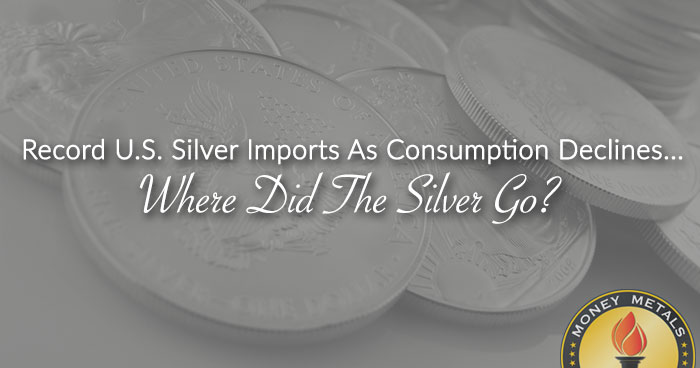Something strange took place in the U.S. Silver market last year. It seems as if the United States imported a record amount of silver in 2016 while its apparent consumption declined considerably. This does not make sense. This means a lot of silver has been acquired and stored, over and above the quantity needed by the U.S. Market.
According to the most recently released data in the USGS 2017 Silver Mineral Commodity Summary, U.S. silver imports reached an estimated record high of 6,300 metric tons (mt) in 2016:

U.S. silver imports last year were 6% higher than in 2015 and 25% higher than the average for 2012-2014. This is quite interesting because silver consumption declined considerably last year. The USGS calculated that apparent U.S. silver consumption decreased from 8,000 mt in 2015 to 7,230 mt in 2016. This is nearly an 800 mt decline in U.S. silver consumption. However, U.S. silver imports increased nearly 400 mt last even as consumption declined:

Even though U.S. silver consumption is higher than imports, we must take into account domestic mine supply and recycling. Also, the USGS calculates “apparent” U.S. silver consumption by the following:
U.S. Apparent Consumption = Mine production + Secondary (new & old scrap) + Imports – Exports – Adjustments for Government and Industrial Stock Changes (including Comex inventories).
So, if overall U.S. silver consumption declined by almost 800 mt, why did silver imports reach a new record high of 6,300 mt?? It seems as if some large entities or institutions are acquiring a lot of silver as overall demand continues to decline.
Furthermore, U.S. silver imports hit another record last year. Total U.S. silver imports of 6,300 mt accounted for 23% of global mine supply in 2016, up from 21% in 2012:

U.S. Silver Imports Now Account for Nearly One-Quarter of Total Global Mine Supply
You will also notice that GFMS – Silver Institute forecasts that the global silver mine supply declined in 2016. Their 2017 World Silver Survey should be out within the next month.
I am speculating here, but it makes a lot of sense for large institutions to acquire silver at this low price before the global stock markets collapse. When the markets finally crash, there won’t be too many high-quality assets to move one’s funds into.
Even though precious metals sentiment and buying are down the first three months of 2017 versus last year… I see this as a very interesting indicator. While some look at this trend as being negative, I look at it as being... THE CALM BEFORE THE STORM.
Additionally, I continue to see more and more precious metals investors becoming frustrated or negative because the metal prices or values have not performed as many have expected. While I thought the gold and silver prices would correct back higher sooner... I am not at all concerned about the timing of this event. However, the revaluation of gold and silver is not decades away as some believe that the Fed and Central Banks will continue manipulating the market indefinitely.
The Fed and Central Banks will hit a brick wall and that is due to the disintegrating energy sector... especially the U.S. and global oil industry. This is precisely why I focus on the energy industry to get an idea of how close we are to ECONOMIC CLIFF.

About the Author:
Independent researcher Steve St. Angelo started to invest in precious metals in 2002. In 2008, he began researching areas of the gold and silver market that the majority of the precious metal analyst community has left unexplored. These areas include how energy and the falling EROI – Energy Returned On Invested – stand to impact the mining industry, precious metals, paper assets, and the overall economy.





